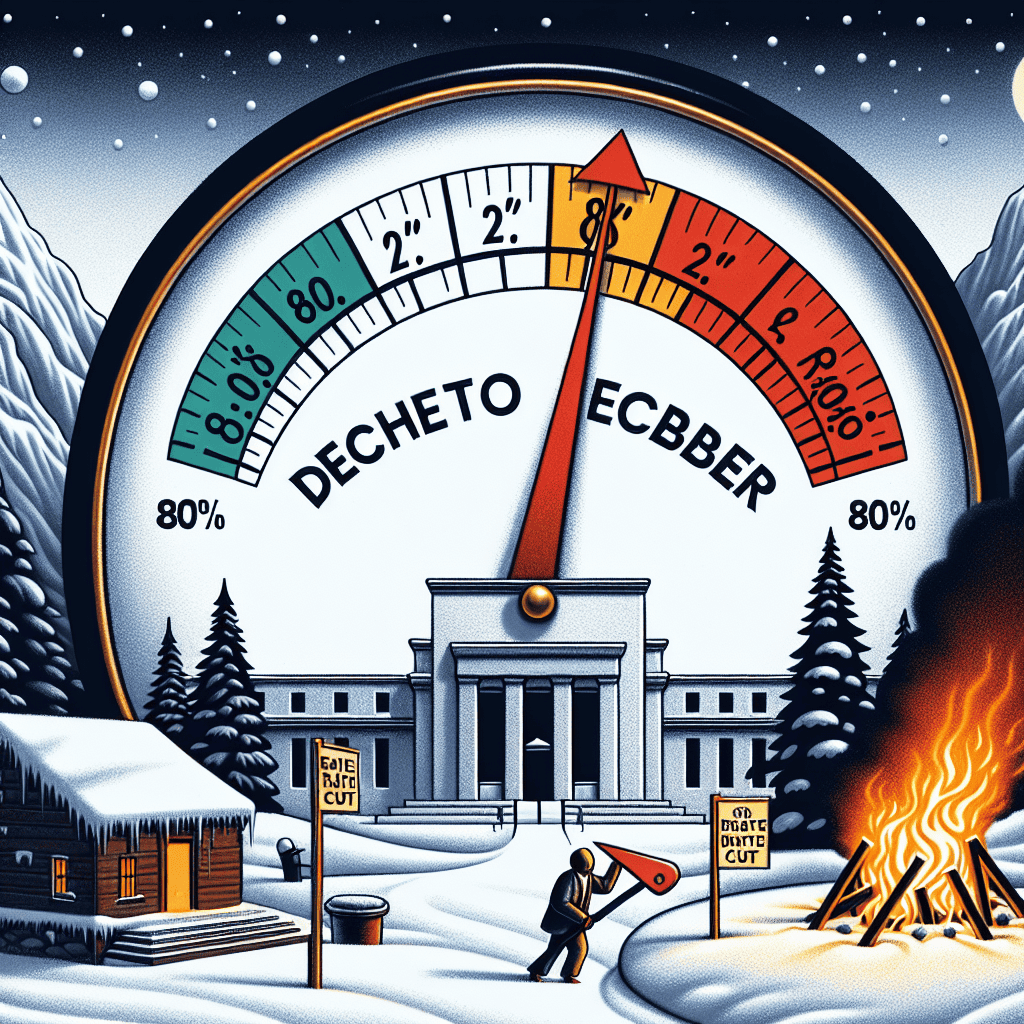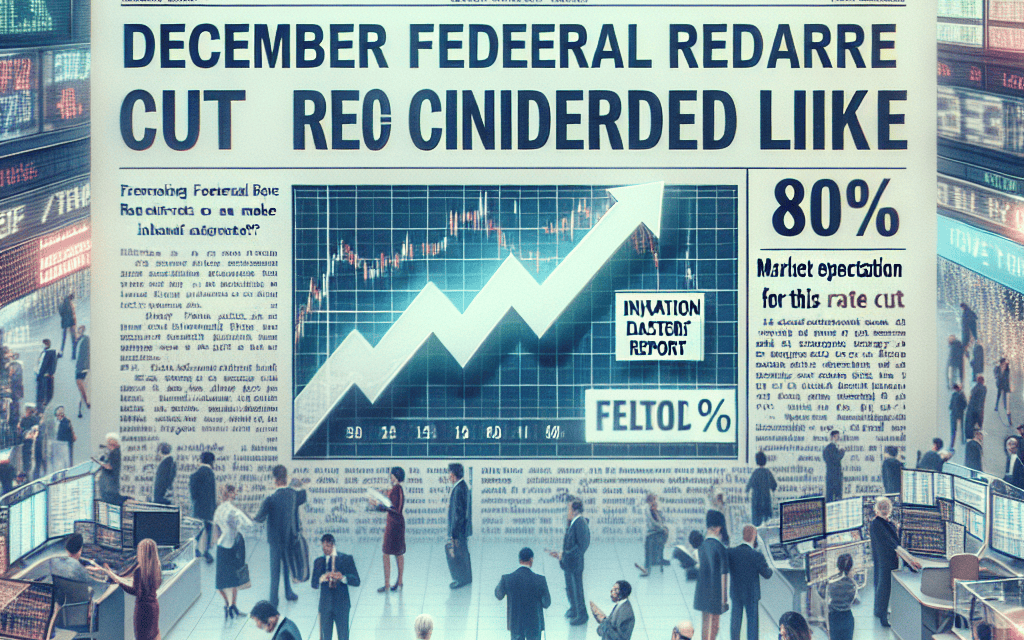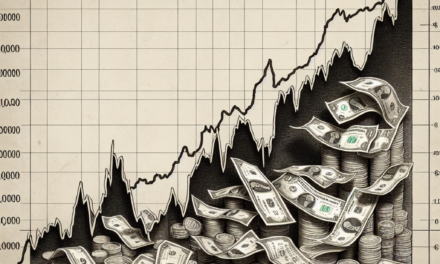“December Rate Cut Looms: Inflation Data Ignites 80% Market Anticipation”
Introduction
In December, the financial markets are abuzz with anticipation as the likelihood of a Federal Reserve rate cut has surged to 80%, driven by recent inflation data. This heightened expectation reflects the central bank’s potential response to cooling inflationary pressures, which have been a focal point of economic policy. As investors and analysts closely monitor the Fed’s next move, the prospect of a rate cut underscores the dynamic interplay between monetary policy and economic indicators, setting the stage for significant implications across financial markets and the broader economy.
Impact Of December Fed Rate Cut On Global Markets
As the global financial landscape continues to navigate the complexities of post-pandemic recovery, the potential for a December Federal Reserve rate cut has captured the attention of investors and policymakers alike. With inflation data fueling an 80% market expectation for this monetary policy adjustment, the implications for global markets are profound and multifaceted. Understanding the potential impact of such a decision requires a comprehensive analysis of both immediate and long-term effects on various economic sectors and regions.
To begin with, a rate cut by the Federal Reserve typically aims to stimulate economic activity by making borrowing cheaper, thereby encouraging spending and investment. In the context of the current economic environment, where inflationary pressures have been a significant concern, a reduction in interest rates could signal the Fed’s confidence in its ability to manage inflation while supporting growth. This move could potentially lead to a depreciation of the U.S. dollar, as lower interest rates generally make a currency less attractive to investors seeking higher returns. Consequently, a weaker dollar could benefit U.S. exporters by making American goods more competitively priced on the global market, potentially boosting trade balances.
Moreover, the ripple effects of a Fed rate cut would likely extend beyond the United States, influencing global financial markets and economies. Emerging markets, in particular, could experience a surge in capital inflows as investors seek higher yields in riskier assets. This influx of capital could provide much-needed support for these economies, many of which have been grappling with the dual challenges of rising debt levels and slowing growth. However, it is essential to consider that while capital inflows can stimulate economic activity, they also carry the risk of creating asset bubbles and increasing financial instability if not managed prudently.
In developed markets, the anticipated rate cut could lead to a reassessment of monetary policies by other central banks. For instance, the European Central Bank and the Bank of Japan might face pressure to adjust their own interest rates to maintain competitive exchange rates and support their respective economies. Such coordinated or reactionary policy shifts could further influence global interest rate trends, impacting everything from government bond yields to corporate borrowing costs.
Additionally, the potential rate cut could have significant implications for the stock markets. Historically, lower interest rates have been associated with higher equity valuations, as cheaper borrowing costs can enhance corporate profitability and encourage investment in growth initiatives. Investors might anticipate a rally in stock prices, particularly in interest-sensitive sectors such as real estate and utilities. However, it is crucial to remain cautious, as market sentiment can be volatile, and the actual impact on equities will depend on a myriad of factors, including corporate earnings and geopolitical developments.
In conclusion, the likelihood of a December Fed rate cut, driven by inflation data and market expectations, presents a complex scenario for global markets. While the immediate effects may include a weaker dollar, increased capital flows to emerging markets, and potential stock market gains, the broader implications will depend on how other central banks respond and how effectively economies can manage the associated risks. As such, investors and policymakers must remain vigilant, continuously assessing the evolving economic landscape to navigate the challenges and opportunities that lie ahead.
How Inflation Data Influences Federal Reserve Decisions
The Federal Reserve’s monetary policy decisions are closely watched by economists, investors, and policymakers alike, as they have far-reaching implications for the economy. One of the most significant factors influencing these decisions is inflation data. As inflation rates fluctuate, the Federal Reserve must carefully consider its approach to interest rates to maintain economic stability. Recently, market expectations have surged to an 80% likelihood of a rate cut in December, driven by the latest inflation data. Understanding how inflation data influences the Federal Reserve’s decisions is crucial to comprehending the broader economic landscape.
Inflation, the rate at which the general level of prices for goods and services rises, erodes purchasing power and can destabilize an economy if left unchecked. The Federal Reserve, tasked with promoting maximum employment and stable prices, uses interest rates as a primary tool to control inflation. When inflation is high, the Fed may increase interest rates to cool down the economy, making borrowing more expensive and saving more attractive. Conversely, when inflation is low, the Fed might lower interest rates to stimulate economic activity by encouraging borrowing and spending.
The recent inflation data has shown signs of easing, prompting speculation about a potential rate cut. This data is critical because it provides the Federal Reserve with insights into the current economic conditions and helps guide its policy decisions. A lower inflation rate suggests that the economy may not be overheating, allowing the Fed more flexibility to adjust interest rates without the risk of exacerbating inflationary pressures. Consequently, the market’s expectation of an 80% chance of a December rate cut reflects a belief that the Fed will act to support economic growth in light of the subdued inflationary environment.
Moreover, the Federal Reserve’s decisions are not made in isolation but are influenced by a myriad of factors, including global economic conditions, employment data, and fiscal policies. However, inflation remains a central concern, as it directly impacts consumer purchasing power and business investment decisions. By closely monitoring inflation trends, the Fed can better anticipate potential economic challenges and adjust its policies accordingly.
In addition to the direct impact on interest rates, inflation data also affects market sentiment and investor behavior. When inflation is perceived to be under control, it can boost investor confidence, leading to increased investment in equities and other riskier assets. Conversely, high inflation can create uncertainty, prompting investors to seek safer havens such as bonds or gold. Therefore, the anticipation of a rate cut in December, fueled by the latest inflation data, has significant implications for financial markets and the broader economy.
In conclusion, the interplay between inflation data and Federal Reserve decisions is a complex but essential aspect of economic policy. As the December meeting approaches, the market’s expectation of a rate cut underscores the importance of inflation data in shaping monetary policy. By understanding how inflation influences the Fed’s decisions, stakeholders can better navigate the economic landscape and anticipate potential shifts in policy. As always, the Federal Reserve will continue to balance its dual mandate of promoting maximum employment and stable prices, using inflation data as a key guide in its decision-making process.
December Rate Cut: What It Means For Borrowers And Savers
As the year draws to a close, financial markets are abuzz with speculation about the Federal Reserve’s next move. The latest inflation data has fueled an 80% market expectation for a rate cut in December, a development that holds significant implications for both borrowers and savers. Understanding the potential impact of this anticipated monetary policy shift is crucial for individuals and businesses alike.
The Federal Reserve’s decision-making process is heavily influenced by economic indicators, with inflation being a key factor. Recent data suggests that inflationary pressures are easing, providing the Fed with more leeway to adjust interest rates. A rate cut, if implemented, would mark a shift from the central bank’s previous stance of tightening monetary policy to combat rising prices. This potential change is largely driven by the need to stimulate economic growth and ensure financial stability.
For borrowers, a rate cut could translate into lower interest rates on loans and mortgages. This would make borrowing more affordable, encouraging individuals and businesses to take on new loans for consumption and investment. Lower borrowing costs can stimulate economic activity by increasing consumer spending and business expansion. Homebuyers, in particular, may find this an opportune time to secure mortgages at more favorable rates, potentially boosting the housing market.
Conversely, savers may face challenges in a lower interest rate environment. Savings accounts and fixed-income investments typically offer returns that are closely tied to prevailing interest rates. A rate cut could lead to reduced yields on these financial products, diminishing the returns for those who rely on interest income. This scenario may prompt savers to seek alternative investment opportunities that offer higher returns, albeit with potentially greater risks.
Moreover, the anticipated rate cut could have broader implications for the financial markets. Lower interest rates often lead to a depreciation of the national currency, as investors seek higher returns elsewhere. This could impact international trade by making exports more competitive while increasing the cost of imports. Additionally, equity markets may react positively to a rate cut, as lower borrowing costs can enhance corporate profitability and investor sentiment.
While the prospect of a December rate cut is largely welcomed by borrowers, it is essential to consider the potential long-term effects on the economy. A prolonged period of low interest rates can lead to asset bubbles and excessive risk-taking, as investors search for higher yields. The Federal Reserve must balance the need for economic stimulus with the risk of financial instability, ensuring that any policy adjustments are carefully calibrated.
In conclusion, the likelihood of a December rate cut by the Federal Reserve has significant implications for both borrowers and savers. While lower interest rates can provide a much-needed boost to economic activity, they also present challenges for those who depend on interest income. As the market anticipates this potential policy shift, individuals and businesses should remain vigilant, assessing their financial strategies in light of changing economic conditions. The Federal Reserve’s decision will undoubtedly be a pivotal moment, shaping the economic landscape as we move into the new year.
Analyzing The 80% Market Expectation For A Fed Rate Cut

As the year draws to a close, financial markets are abuzz with speculation regarding the Federal Reserve’s next move on interest rates. The latest inflation data has significantly influenced market sentiment, leading to an 80% expectation of a rate cut in December. This anticipation is rooted in a confluence of economic indicators and strategic considerations that the Federal Reserve must weigh carefully. Understanding the factors driving this expectation requires a closer examination of the current economic landscape and the Fed’s policy objectives.
To begin with, the recent inflation data has been pivotal in shaping market expectations. Inflation, which had been persistently high, has shown signs of moderation, suggesting that the Federal Reserve’s previous rate hikes are beginning to take effect. This deceleration in inflationary pressures provides the Fed with some leeway to consider easing monetary policy. Moreover, the central bank’s dual mandate of promoting maximum employment and stabilizing prices necessitates a balanced approach. With inflation appearing to be under control, the focus may shift towards supporting economic growth and employment, especially if there are signs of a slowdown.
In addition to inflation data, other economic indicators are contributing to the anticipation of a rate cut. Recent reports on consumer spending and business investment have shown mixed results, indicating potential vulnerabilities in the economy. A rate cut could serve as a preemptive measure to bolster economic activity and mitigate any adverse effects from global uncertainties. Furthermore, the international economic environment remains fraught with challenges, including geopolitical tensions and trade disruptions, which could impact domestic economic stability. By reducing interest rates, the Fed could provide a buffer against these external risks, ensuring that the U.S. economy remains resilient.
Transitioning to the Federal Reserve’s strategic considerations, it is important to note that the central bank has been cautious in its communication, emphasizing data dependency and flexibility. This approach allows the Fed to adapt its policy stance in response to evolving economic conditions. The high market expectation of a rate cut reflects confidence in the Fed’s commitment to supporting the economy, but it also underscores the importance of clear communication to manage market expectations effectively. The Fed’s decision-making process involves a careful assessment of both current data and forward-looking projections, ensuring that any policy adjustments align with long-term economic goals.
Moreover, the potential rate cut in December would not occur in isolation but as part of a broader monetary policy strategy. The Fed has been navigating a complex economic environment characterized by rapid changes and uncertainties. By considering a rate cut, the central bank aims to maintain a supportive monetary environment that fosters sustainable growth. This decision would also signal the Fed’s responsiveness to economic conditions, reinforcing its role as a stabilizing force in the financial system.
In conclusion, the 80% market expectation for a December Fed rate cut is driven by a combination of moderating inflation, mixed economic indicators, and strategic considerations by the Federal Reserve. As the central bank evaluates its next steps, it must balance the need to support economic growth with its commitment to price stability. The anticipation of a rate cut reflects market confidence in the Fed’s ability to navigate these challenges effectively, ensuring that monetary policy remains aligned with the evolving economic landscape. As December approaches, all eyes will be on the Federal Reserve, awaiting its decision and the implications it holds for the future trajectory of the U.S. economy.
Historical Context: Fed Rate Cuts In Response To Inflation
The Federal Reserve’s monetary policy decisions have long been a focal point for economists, investors, and policymakers alike. Historically, the Fed has adjusted interest rates in response to various economic indicators, with inflation being a primary concern. As we approach December, market expectations for a rate cut have surged to 80%, driven by recent inflation data that suggests a cooling economy. To understand the potential implications of this anticipated move, it is essential to examine the historical context of Fed rate cuts in response to inflationary pressures.
In the past, the Federal Reserve has often employed rate cuts as a tool to stimulate economic activity during periods of low inflation or deflationary threats. For instance, during the financial crisis of 2008, the Fed aggressively slashed interest rates to near zero in an effort to bolster economic growth and stave off deflation. This period marked a significant shift in monetary policy, as the central bank sought to provide liquidity and encourage borrowing and investment. The success of these measures in stabilizing the economy underscored the importance of interest rate adjustments in managing inflationary trends.
Transitioning to more recent times, the COVID-19 pandemic presented a unique set of challenges for the Federal Reserve. In response to the economic downturn caused by the pandemic, the Fed once again reduced interest rates to near-zero levels in 2020. This move was aimed at supporting economic recovery by making borrowing cheaper for consumers and businesses. However, as the economy rebounded, inflationary pressures began to mount, prompting the Fed to gradually increase rates in subsequent years to prevent the economy from overheating.
Now, as we look towards December, the current inflation data suggests a potential shift in the Fed’s approach. Recent reports indicate that inflation is beginning to moderate, with price increases slowing across various sectors. This development has fueled market expectations for a rate cut, as investors anticipate that the Fed may seek to support continued economic growth by easing monetary policy. The 80% likelihood of a December rate cut reflects a growing consensus that the central bank will prioritize sustaining economic momentum over combating inflation, which appears to be under control.
Moreover, the global economic landscape adds another layer of complexity to the Fed’s decision-making process. With geopolitical tensions and supply chain disruptions still impacting markets, the Fed must carefully weigh the potential risks and benefits of a rate cut. A reduction in interest rates could provide a much-needed boost to the economy, but it also carries the risk of reigniting inflationary pressures if not managed carefully.
In conclusion, the historical context of Fed rate cuts in response to inflation provides valuable insights into the potential implications of a December rate cut. As inflation data continues to shape market expectations, the Federal Reserve faces the challenging task of balancing economic growth with price stability. The anticipated rate cut reflects a strategic response to evolving economic conditions, underscoring the Fed’s commitment to fostering a stable and prosperous economic environment. As we await the Fed’s decision, the interplay between inflation data and monetary policy will remain a critical area of focus for stakeholders across the financial spectrum.
Investor Strategies Ahead Of A Potential December Rate Cut
As the financial markets brace for a potential interest rate cut by the Federal Reserve in December, investors are keenly evaluating their strategies to navigate the anticipated shift in monetary policy. The likelihood of a rate cut has surged to 80%, driven by recent inflation data that suggests a cooling economy. This development has significant implications for investment portfolios, prompting market participants to reassess their positions and consider adjustments that align with the evolving economic landscape.
The prospect of a rate cut typically signals a more accommodative monetary stance, aimed at stimulating economic activity by making borrowing cheaper. For investors, this environment often translates into a favorable backdrop for equities, as lower interest rates can boost corporate profits by reducing debt servicing costs. Consequently, many investors are contemplating increasing their exposure to stocks, particularly in sectors that are sensitive to interest rate changes, such as technology and consumer discretionary. These sectors often benefit from increased consumer spending and investment in innovation, driven by lower borrowing costs.
Moreover, the bond market is also poised for adjustments. A rate cut generally leads to a decline in bond yields, as prices move inversely to interest rates. Investors holding long-duration bonds may see capital appreciation, making these instruments attractive in the short term. However, with yields potentially declining further, some investors might seek to diversify their fixed-income portfolios by exploring corporate bonds or high-yield bonds, which offer higher returns albeit with increased risk.
In addition to equities and bonds, real estate investments could also gain traction in a low-interest-rate environment. Lower mortgage rates can spur demand for housing, driving up property values and rental income. Real estate investment trusts (REITs) may become more appealing, offering investors a way to capitalize on the potential uptick in the real estate market while providing a steady income stream through dividends.
While the anticipation of a rate cut presents opportunities, it also necessitates caution. Investors must remain vigilant about the broader economic context, as the underlying reasons for the Fed’s decision to cut rates—such as slowing growth or persistent inflationary pressures—could pose risks. Diversification remains a key strategy, allowing investors to mitigate potential downsides while capturing upside potential across different asset classes.
Furthermore, the global economic environment should not be overlooked. International markets may react differently to a U.S. rate cut, influenced by their own economic conditions and monetary policies. Investors with global exposure should consider the implications of currency fluctuations and geopolitical developments, which could impact returns.
In conclusion, as the December Fed rate cut looms on the horizon with an 80% market expectation, investors are strategically positioning themselves to capitalize on the potential benefits while safeguarding against inherent risks. By carefully analyzing the implications of a lower interest rate environment across various asset classes, investors can make informed decisions that align with their financial goals. As always, maintaining a balanced and diversified portfolio remains paramount, ensuring resilience in the face of economic uncertainties and market volatility.
The Role Of Inflation In Shaping Monetary Policy Decisions
In recent months, the financial markets have been abuzz with speculation regarding the Federal Reserve’s next move, particularly in light of the latest inflation data. As December approaches, the likelihood of a rate cut by the Federal Reserve has surged to 80%, driven by a confluence of economic indicators that suggest a shift in monetary policy may be imminent. Understanding the role of inflation in shaping these decisions is crucial for comprehending the broader economic landscape and the Fed’s strategic approach.
Inflation, a key economic indicator, plays a pivotal role in the Federal Reserve’s decision-making process. It reflects the rate at which the general level of prices for goods and services is rising, thereby eroding purchasing power. Central banks, including the Federal Reserve, aim to maintain inflation at a moderate level, typically around 2%, to ensure economic stability. When inflation deviates significantly from this target, it prompts the Fed to adjust its monetary policy tools, such as interest rates, to steer the economy back on course.
The recent inflation data has been a cause for concern among policymakers and market participants alike. Over the past year, inflation has consistently exceeded the Fed’s target, driven by a combination of supply chain disruptions, labor market imbalances, and robust consumer demand. These factors have contributed to persistent price pressures, compelling the Federal Reserve to reassess its policy stance. Consequently, the prospect of a rate cut in December has gained traction as a potential measure to address these inflationary challenges.
Moreover, the Federal Reserve’s dual mandate of promoting maximum employment and stable prices further underscores the importance of inflation in its policy decisions. While the labor market has shown signs of recovery, with unemployment rates gradually declining, the persistent inflationary pressures pose a threat to economic stability. By potentially cutting interest rates, the Fed aims to stimulate economic activity, encourage borrowing and investment, and ultimately alleviate some of the inflationary pressures that have been weighing on the economy.
In addition to domestic factors, global economic conditions also influence the Federal Reserve’s approach to inflation and interest rates. The interconnectedness of the global economy means that inflationary trends in other major economies can have spillover effects on the United States. For instance, rising energy prices and geopolitical tensions can exacerbate inflationary pressures, prompting the Fed to consider preemptive measures to mitigate potential risks. Thus, the decision to cut rates in December would not only reflect domestic economic conditions but also take into account the broader global economic environment.
As market expectations for a December rate cut reach 80%, it is essential to recognize the implications of such a move. A rate cut would signal the Federal Reserve’s commitment to addressing inflationary concerns and supporting economic growth. However, it also carries potential risks, such as fueling asset bubbles or undermining the Fed’s credibility if inflation remains persistently high. Therefore, the decision to adjust interest rates is a delicate balancing act that requires careful consideration of various economic indicators and potential outcomes.
In conclusion, the role of inflation in shaping monetary policy decisions is both complex and multifaceted. As the Federal Reserve contemplates a rate cut in December, driven by an 80% market expectation, it must weigh the benefits of stimulating economic activity against the risks of exacerbating inflationary pressures. By closely monitoring inflation trends and other economic indicators, the Fed aims to navigate these challenges and ensure a stable and prosperous economic future.
Q&A
1. **What is the current market expectation for a December Fed rate cut?**
The market expectation for a December Fed rate cut is 80%.
2. **What is driving the expectation for a Fed rate cut in December?**
The expectation is driven by recent inflation data.
3. **How does inflation data influence the Federal Reserve’s decision on interest rates?**
Lower inflation data can lead to expectations of a rate cut as the Fed aims to support economic growth.
4. **What is the potential impact of a Fed rate cut on the economy?**
A rate cut can stimulate economic activity by making borrowing cheaper, encouraging spending and investment.
5. **How do market participants gauge the likelihood of a Fed rate cut?**
Market participants use tools like futures contracts and economic indicators to assess the likelihood.
6. **What role does the Federal Reserve play in managing inflation?**
The Federal Reserve manages inflation through monetary policy, primarily by adjusting interest rates.
7. **What are the risks associated with a premature rate cut by the Fed?**
A premature rate cut could lead to overheating the economy or insufficient control over inflation.
Conclusion
The likelihood of a December Federal Reserve rate cut has increased significantly, with market expectations reaching 80% due to recent inflation data. This data suggests that inflationary pressures are easing, providing the Fed with more flexibility to adjust monetary policy. A rate cut could stimulate economic growth by lowering borrowing costs, encouraging investment, and boosting consumer spending. However, the Fed will likely weigh this decision against other economic indicators and potential risks to ensure that any policy change aligns with its broader economic objectives.





